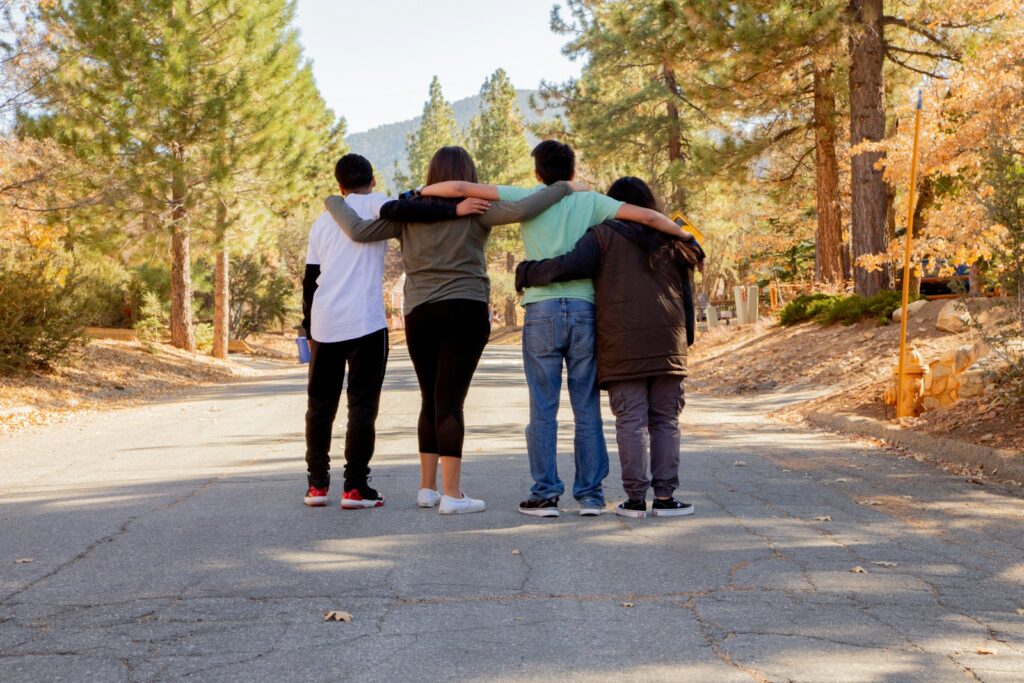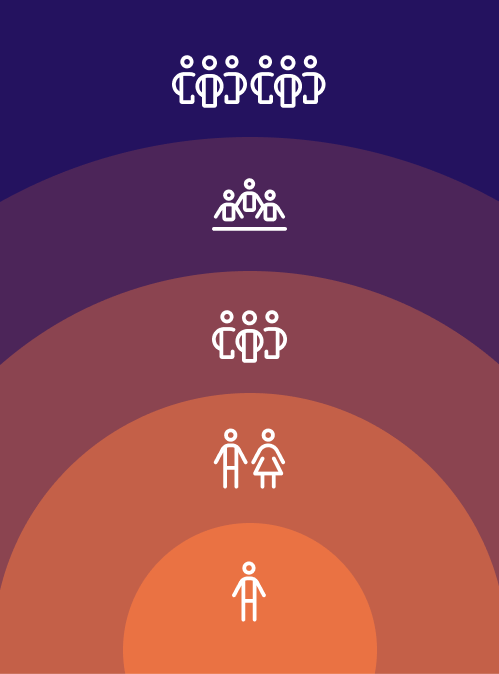Understanding Childhood Trauma & Adversity
What is Childhood Adversity?

Childhood adversity refers to a wide range of circumstances or events that pose a serious threat to a child’s physical or psychological well-being. Childhood adversity may occur during prenatal development and all other developmental stages, from infancy through adolescence. Prolonged or severe childhood adversity can disrupt typical development, especially when protective factors are absent. Children and adolescents who experience traumatic adversity may struggle with cognitive development, relationship building, or controlling and regulating their emotions. This can affect a child’s ability to succeed in school or maintain healthy relationships, which can then lead to cycles of adversity that echo through several generations. Learning to recover from any level of adversity is an important part of development that children and adults learn in relationship with others.
Adversity at any age can be traumatic, but not all adversity results in trauma. Many adverse childhood experiences, such as abuse, neglect, or exposure to violence, have the potential to be traumatic for a child, especially without consistent safety and support. Research shows that protective factors significantly reduce the traumatic impact of adversity. These include having basic needs met, forming safe and nurturing relationships with trusted adults, and accessing culturally responsive mental and behavioral healthcare. The more severe and chronic the adversity, the greater the risk of it resulting in trauma.
Types of Adversity
Childhood adversity occurs at multiple, interconnected levels. The following identify some, but not all, forms of adversity experienced at the individual, community, and societal levels. This is adapted from Adapted from Ellis W. Dietz W., BCR Framework. Academic Peds (2017).

Adverse Childhood Experiences
- Abuse — emotional, sexual, physical
- Substance abuse
- Domestic violence
- Neglect — physical, emotional
- Parental separation
- Mental illness
- Incarceration

Adverse Community Environments
- Poverty
- Racism, discrimination
- Poor/unaffordable housing
- Community violence
- Lack of educational, economic opportunity

Adverse Collective Historical Experiences
- Mass incarceration
- Slavery
- Genocide
- Holocaust
- Forced displacement
What is Trauma?
Trauma is the experience of interruptions in safety, agency, dignity, or belonging that overwhelm a person’s coping abilities. This can lead to temporary and/or lasting adverse effects on the individual’s functioning and mental, physical, social, emotional, and/or spiritual well-being.
We often think about trauma only individually, yet it is important to grasp that trauma manifests at interconnected levels. Harmful formal and informal social structures, policies, and ideologies actively worsen traumatic experiences. Furthermore, families, groups of people like first responders, and entire communities carry trauma across generations, racial lines, or cultural contexts.
Community-level trauma involves cultural, racial, and historical or generational experiences of adversity, such as climate-related disasters like hurricanes and floods, systemic racism, pandemics, forced displacement and genocide. These experiences can be passed down as intergenerational trauma through epigenetics. This means that when someone experiences trauma, their body may adjust gene expression to adapt. While this adjustment does not alter the DNA sequence, it can affect how the body reads and responds to the DNA. These changes have the potential to negatively affect the health of future generations. However, reducing risk and increasing protective factors can disrupt or even eliminate the transmission of this intergenerational trauma.
Systemic inequities in healthcare, government, and education lead to disparities in both trauma exposure and its impacts. Specifically, these inequities cause Black, Hispanic, and Native American communities to experience more secondary disaster-related trauma. This includes trauma from displacement, slow infrastructure recovery, limited healthcare access, and the loss of social networks after a disaster.
Types of Trauma¹
Mass Trauma
Affects large numbers of people
Community Trauma
Impacts a few people but has structural or social traumatic consequences
Racial Trauma
A reaction or response to racial discrimination, which is the direct experiences of conflict, hatred, injury, or threatened harm to an individual based on their race.
Historical or Generational Trauma
Widespread trauma that affects an entire culture and influences generations of the culture beyond those who experience it directly.
Group Trauma
Affects a particular group, e.g., military service members, first responders, LGBTQI+ community
Family Trauma
Affects multiple members within a family
Individual Trauma
Affects one person

Impact of Childhood Adversity and Trauma
Childhood adversity and trauma affect a significant number of Louisiana’s children and families, potentially disrupting all aspects of health. America’s Health Rankings (2023) reports that Louisiana ranks 49th in overall child well-being in the U.S., with one of the highest rates of children per capita experiencing two or more adverse events in childhood. Research reveals that toxic stress from unbuffered traumatic experiences can lead to long-term health problems like diabetes and heart disease in children. This affects their well-being and can potentially impact future generations through epigenetic changes and the intergenerational transmission of adversity.
Failing to address childhood adversity and its impacts disrupts all social-ecological levels and incurs substantial economic costs for Louisiana. In North America, the estimated financial cost of childhood adversity-related health consequences is estimated at $748 billion annually. Failing to recognize these experiences and respond in ways grounded in the science of adversity and resilience can have profound consequences for Louisianan’s well-being.
Protective Factors
The Centers for Disease Control and Prevention (CDC) report the following protective factors for childhood adversity and trauma, occurring both before and after adversity, make a significant impact. On the individual level these include connecting youth to activities and caring adults, teaching essential healthy relationship and emotional regulation skills, and offering accessible, culturally responsive therapy or treatment options to mitigate immediate and long-term harms. Protective factors on the community level include leveraging our policies and programs to actively and positively impact the social determinants of health that sustain healthy families and communities. These include, but are not limited to, enacting policies to address drivers of structural and systemic inequities, robust health and educational systems, supportive access to basic needs (housing, food, water), and family-friendly policies in the workplace that support and protect employees.
Increasing access to protective factors ensures that core needs — safety, agency, dignity, and belonging — are met, which is crucial for individual and collective wellbeing.2
Safety
A sense of being physically, psychologically, and emotionally secure. Having all basic needs met in ways that do not cause harm or exploitation.
Agency
The ability to make a decision, experience reasonable consequences for that decision, and make another decision.
Dignity
A sense of power and worthiness that is not based on harm or dehumanization.
Belonging
Being a full and accepted member of a group. Being in meaningful relationships with people, the planet, spirit, and/or other living beings.
Deepening Our Recognition
The Whole Health Louisiana State Plan is built on a foundation of understanding the drivers of trauma and developing goals and strategies that both acknowledge and address them. Louisiana’s approach to collaboration and community-specific care will require a trauma-informed and healing-centered transformation so that together, we can effectively recognize, prevent, and treat childhood adversity and its effects at all levels, allowing the people of Louisiana to access their full potential. The four priority areas identified in the Whole Health Louisiana State Plan — collaboration, awareness, workforce, and prevention — address the drivers of childhood adversity and its impacts with a data-driven, cross-sector approach that can improve outcomes for Louisiana’s residents.
To achieve our mission, we must recognize the drivers of racial trauma and respond to the complex impacts of experiencing or witnessing racism, discrimination, or structural inequities caused by institutional racism. To that end, the Whole Health Louisiana State Planning Team engaged Dr. Denese Shervington, an expert in public health and clinical and academic psychiatry specializing in healing from historical, intergenerational, interpersonal, and community trauma. Her guidance ensured planning partners understood the impacts of racialized trauma, which then informed the development of plan goals.
References
- Source: SAMHSA’s Practical Guide for Implementing a Trauma-Informed Approach https://www.samhsa.gov/resource/ebp/practical-guide-implementing-trauma-informed-approach
- Source: McGlynn-Wright, T., & Briner, L. (2021, March 30). Integrative Trauma and Healing Framework. In the Works. Retrieved from https://intheworksllc.squarespace.com/inflections/2021/3/30/integrativetrauma-and-healing-framework
